Back in March we welcomed our new Student Collections Care Assistants; Abigail Miskin, Ella Joyce and Isabela Tapia Hernandez. Four months on and it is time to say goodbye and thank you to the first, Abigail, who has been offered an amazing opportunity to shadow a team of conservators in Italy, learning Paintings Conservation and develop on the skills she has learned here with us.
The Collections Care Assistant role was created for our students to explore the cultural heritage sector through employment and support their career aspirations post-graduation. This inaugural year involved collaborative efforts to optimise the role for students, collections, and service. Abigail, Ella and Isabela exhibited exceptional communication, maturity, flexibility, and a willingness to learn, making the role’s first year highly successful. These qualities also allowed the established team members to learn and improve the role, which we aim to continue offering in 2024-25 and beyond.
This is the first of three blog posts detailing their time with us!
My name is Abigail and I am currently an undergraduate Fine Art student interested in pursuing a career in Art Conservation. For the past few months, I have been working at the Centre for Research Collections (CRC) as a collections care assistant after expressing a desire to gain some experience in the heritage sector. This job opportunity has been extremely valuable to me both in gaining practical experience, and learning more about the different aspects of collections care and archiving. My time at the CRC has been incredibly fulfilling and varied, I have worked both onsite and offsite and undertaken an array of tasks in a range of different departments. In reflection of my time working with the heritage collection, I would like to share an overview of the amazing experiences I have had and the fascinating artworks and documents I have been lucky enough to work with.
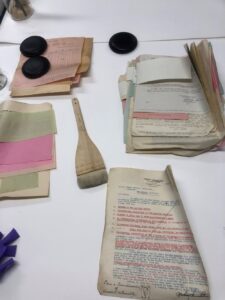
A bundle of papers currently in an unsuitable state of condition requiring cleaning, flattening and rehousing. I used a smoke sponge and a light hake brush to gently clean off all the surface dirt.
At the end of April, I began working with Amanda (the teams Paper Conservator) and Amy (the teams Book Conservator) in the conservation studio, and I was immediately aware of the rewarding and important nature of conservation work. I started my placement during the ‘Panoramas: the World in 360°’ exhibition, currently being shown on the ground floor of the Main library. During these first weeks, I learnt a wide range of techniques regarding the cleaning, repair and presentation of these panorama works. Under the guidance of my colleagues, I learned how to make display corners and support mounts, how to remove surface grime, and how to make and use wheat starch paste to perform tear repairs. These weeks set me up with a strong understanding of the tools and methods needed for paper conservation work and also gave me a glimpse into all of the work that goes into creating an exhibition.
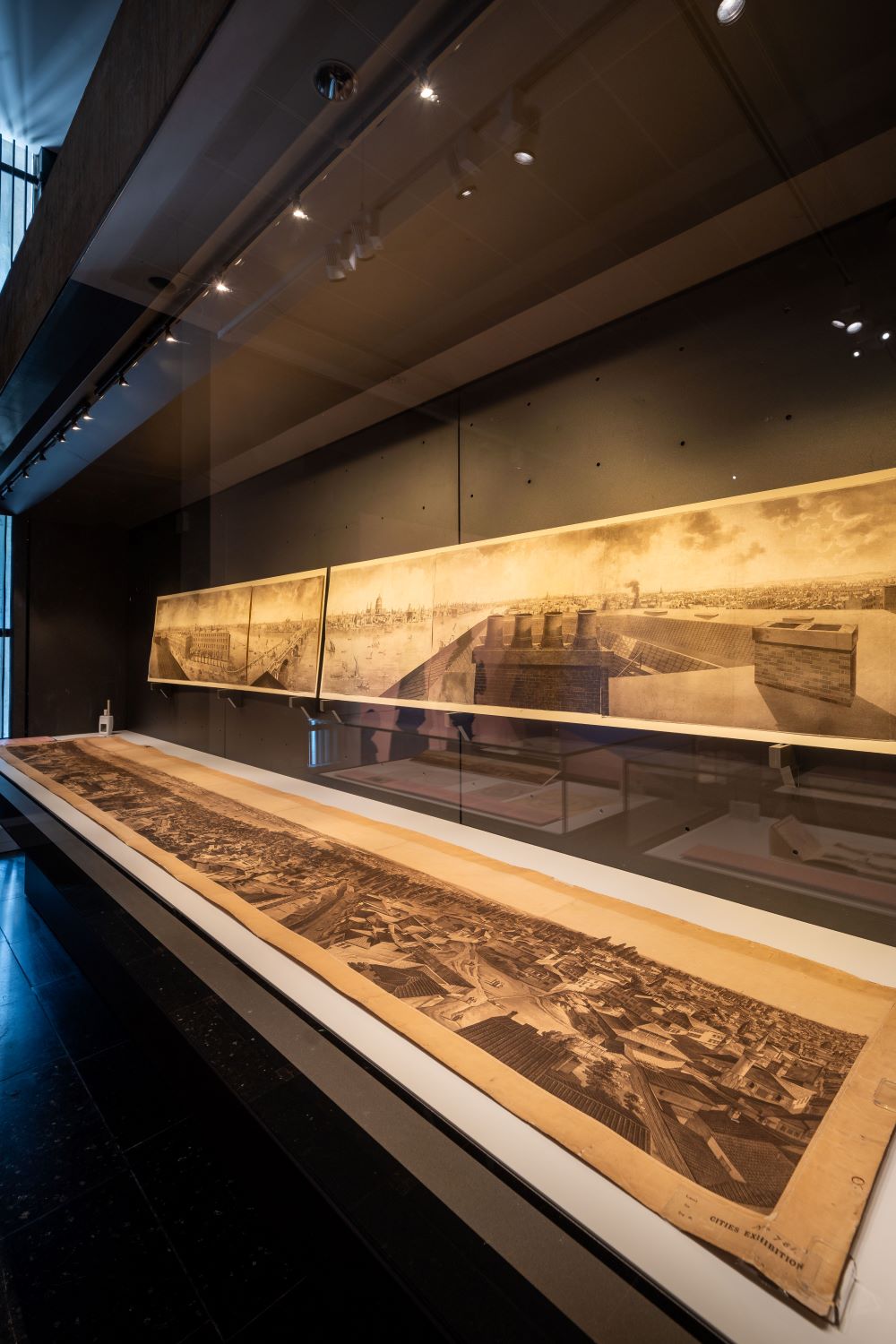
Two of the large Panoramas of London and Constantinople featuring in the exhibition.
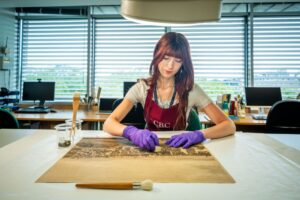
Using a smoke sponge to clean the panoramic plate.
Throughout my time, I was consistently reusing the skills I had developed during the panoramas project but, learned a lot more about re-housing and storage of the collections as well as their presentation. I spent time on many projects such as documenting of the lengthy Tom Kidd digital collection and later became especially committed to the treatment and rehousing of the John levy Taiwanese collection so that it could be safely consulted in the reading room. It was incredibly satisfying to know my work was making it possible for these records to be accessible to the public and fellow students and so I felt particularly motivated by this project.
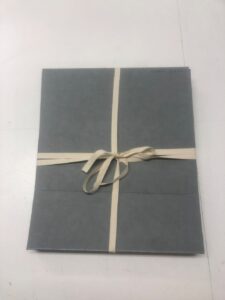
Rehousing example of the John levy Taiwanese collection.
Alongside working on these more time-consuming tasks, Amy and Amanda were extremely helpful in teaching me about book and paper consolidation methods, demonstrating a range of these and teaching me to perform them myself. I particularly enjoyed learning about red rot and how we can stabilize deteriorating parts of the collection to prevent losing them entirely and to reduce their potentially harmful effects when it comes to public handling.
My time working as a collections care assistant was not restricted to my work just at the Main Library, I was lucky enough to make various trips to other establishments within and outside of the University. I spent time at the Universities collections facility (UCF) performing various housekeeping activities and learning about the wide range of material stored in the collection’s unit. As well as visiting the UCF, I paid visits to Kings’ Buildings and more specifically the Grant Institute, engaging with the vast geology collection stored there. Working primarily to rehouse broken glass-plate negatives, positives and slides. I truly felt that during my time I got to handle and see many different areas of the Universities heritage collection which is much larger, widespread and diverse than I could have imagined.
I have not only seen a huge amount of the university’s collections but, have also learnt about the archives and collections of other establishments. I was able to visit the National Galleries visiting Modern Two where their Conservation and Collections team are based learning about their facilities, projects and methods of collections care which was incredibly interesting and beneficial. I have also been lucky enough to attend an ICON Scotland event ‘5-minutes Presentations’ hosted by the National Libraries of Scotland where conservators come together for an afternoon of discussion and networking. I felt so privileged to hear so many different professionals discuss their projects – new and upcoming, new techniques and how different people use different materials.
As well as learning about the conservation and archiving of bound and paper objects, I have gained experience with the treatment of other materials which has broadened my knowledge and given me further insight into the variety of objects within the University’s collection. Towards the end of my time at the CRC, I worked closely with Amanda on some of the badly water damaged glass-plate negatives from the Royal Zoological Society of Scotland’s Archive, which has been recently acquired into the University’s collection. After previously working through old correspondences of Thomas Gillespie (founder of Edinburgh Zoo and of its parent organisation the Royal Zoological Society of Scotland), getting to continue my work with associated material and taking a deeper look into the Zoo’s history has been fascinating. I have now finished cleaning and making individual four flap folders for these plates and have fitted them into new cushioned boxes as to avoid any further damage.
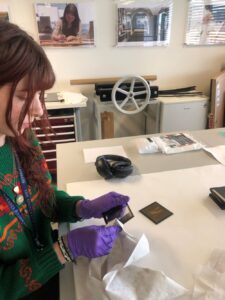
Cleaning glass plate negatives from the Royal Zoological Society of Scotland’s Archive.
My job as a Collections Care Assistant has taught me the huge impact and responsibility of those working in the heritage sector on making collections accessible and safe and most importantly preserving their structural integrity for the future. During my time, I have seen the fascinating and historically rich nature of the University’s collections as well as the efforts that every department and member of staff puts into maintaining them. I have found an immense appreciation for the work carried out at the CRC as well as an even stronger motivation to continue working in the heritage sector. I wanted to take this chance to say a huge thank you to the CRC team for allowing me to help with all of these amazing projects over these past months. I have had the most amazing time and have learnt so much.
Thank you! And stay tuned for the next two blogs from my fellow Collections Care Assistants.
Abigail Miskin
Student Collections Care Assistant.

Fascinating insight into the intricate, delicate and important work of archives and the treasures that the obtain, preserve and make available. Privileged as University of Edinburgh volunteer to view some crc archive materials. Huge praise to a involved. Many thanks.